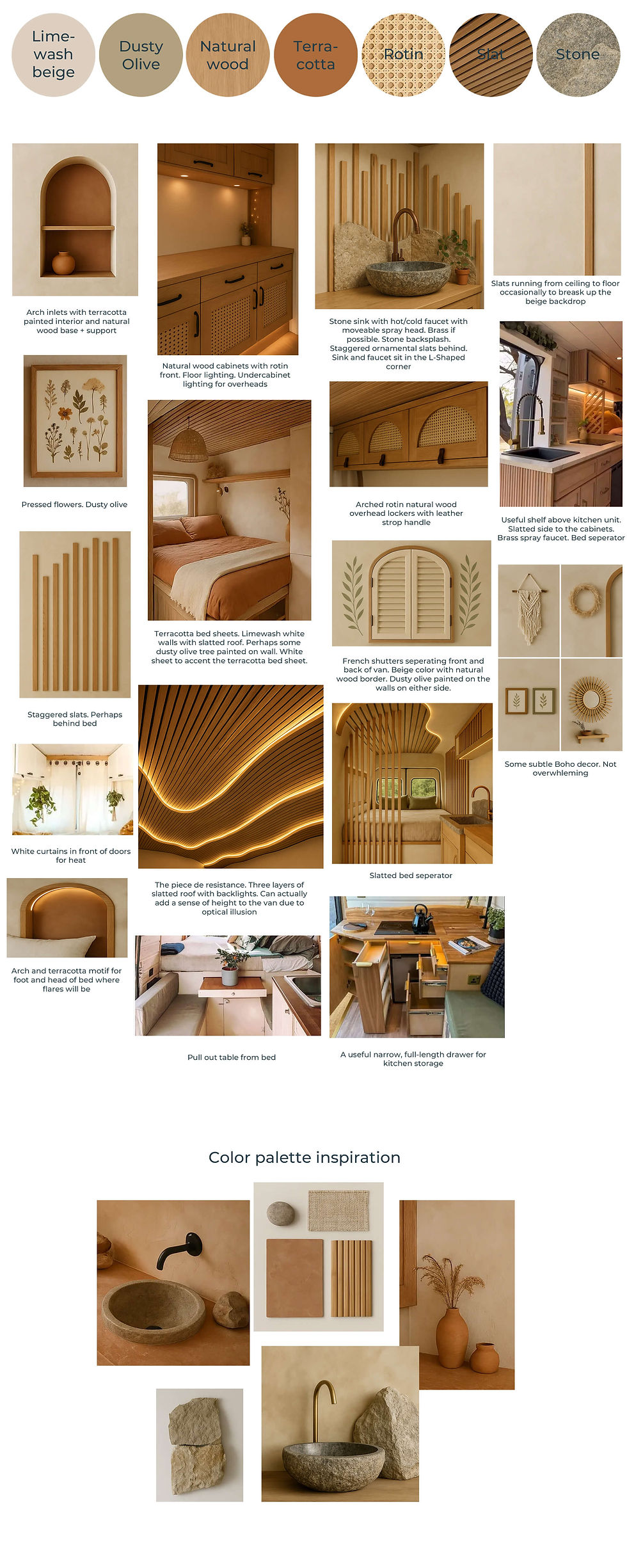I've bought a brand new L3H3 Citroen Relay for myself. It should arrive any day now, so I've been trying to plan everything before it arrives!
One of the things I've spent a lot of time on is design. The more planning you do up front, the easier it gets down the line.
Here is my current mood-board / design doc so far;
(I describe my design process at the bottom of this post)

Here was my process:
🔎 Step 1: Collecting Inspiration
The first phase was simply soaking in inspiration. I trawled the internet for days looking through every van interior I could find. The key sources that helped me most were:
Van conversion websites – There are plenty of great websites with inspiration, beyond TheVanConversion.com ;)
Pinterest – great for aesthetics and general vibes.
YouTube van tours – particularly for spatial layouts and clever hidden features.
Instagram – to get a feel for how people are styling things now.
Quirky Campers & Outdoorsy – these were incredibly helpful. Both sites let you scroll through dozens (or hundreds) of real-world campervan conversions, which was gold for design research.
As I browsed, I screenshotted every little feature that caught my eye:
curved cabinetry
slatted wall ornamentation
clever pull-out table designs
texture combos (wood + limewash + stone)
soft lighting ideas
boho detailing
arch motifs and shutter shapes
drawer arrangements
colour palettes and ceiling textures
Each screenshot went into a big Word doc alongside a quick note or description explaining why I liked that detail.
Alongside design inspiration, I also noted functional design features, for example: where the water tanks will go, whether I wanted flares or not, which water system I would use, etc.
I started to play around with different layout plans which I sketched on paper - this is the one I've gone for (very basic sketch):

🧠 Step 2: Spotting Themes & Refining Style
After immersing myself in examples, I started noticing recurring motifs that really resonated with me. I naturally leaned toward:
earthy, natural materials (wood, stone, rotin, plaster)
curved or arched forms (no hard corners!)
soft, ambient lighting with built-in glows
subtle bohemian touches—pressed flowers, soft linens, textured fabrics
stone sinks and warm tones
limewash-style walls and a slatted wood ceiling
At this point, it wasn’t just about finding ideas—I was starting to refine a coherent design language. The aesthetic became grounded, warm, natural, and minimal with handcrafted soul. I could finally answer the question: “What does my van feel like?”
I put together a colour document to use going forward:
1. Main Wall Colour – Limewash Beige
Hex: #d8cab6
Name: French Clay / Raw Linen
Description: A warm, natural beige with soft chalky tones—ideal for limewash or mineral-based paints like Bauwerk’s Raw White or Mushroom.
Use for: Walls, arch cut-outs, shutters
2. Primary Accent – Terracotta
Hex: #ac6d3c
Name: Burnt Terracotta
Description: A rich, sun-baked red-brown. Warm and grounding.
Use for: Drawer fronts, arch inlets, tiles, faucet or metalware accents
3. Secondary Accent – Dusty Olive
Hex: b3a17e
Name: Pressed Sage / Dusty Olive
Description: Muted olive with grey undertones, reminiscent of dried eucalyptus or vintage pressed plants.
Use for: Floral motifs on shutters, drawer pulls, mini planters
4. Natural Wood
Hex: #A67C52
Name: Honey Oak / Light Walnut
Description: A warm mid-tone natural wood, satin or oiled finish.
Use for: Slats, cabinetry, shutter frames, shelving, overhead locker fronts
5. Rotin / Cane
Hex: #E5C99C
Name: Bleached Woven Rattan
Description: Light woven fiber tone, slightly golden
Use for: Overhead locker panels, cabinet inserts
6. Soft White (Textiles & Linen)
Hex: #F5F2ED
Name: Off-White Linen
Description: A very soft white with beige undertones—not stark, not cold
Use for: Bedding, cushions, curtains
🤖 Step 3: Using AI for Visualization
This was a game-changer. I started using ChatGPT’s DALL·E image generation tool, which has come so far since I first tested it a couple of years ago.
I prompted the tool to generate specific design elements I was considering. For example:
“Natural wood overhead cabinets with rotin inserts and leather strap handles”
“A slatted wooden ceiling with integrated LED backlighting in a campervan”
“Earthy boho van interior with terracotta accents and a stone sink”
“A campervan bed with arch-shaped wooden flare cutouts and limewash walls”
“Corner sink area with stone bowl, wooden slats, and wall-mounted faucet”
This helped me visualize things that didn’t exist yet, which really pushed the design forward. It let me quickly test ideas and combine elements I’d seen in different places into a unified look. I’d often go back and forth with ChatGPT, iterating on small tweaks until it looked right—like adjusting curve radius, changing lighting direction, or matching wood tones more closely.
🖼 Step 4: Assembling the Moodboard
After a ton of back-and-forth and visual exploration, I pulled everything together into a single comprehensive moodboard (see attachment).
The final board includes:
My chosen color palette: Limewash beige, dusty olive, natural wood, terracotta, rotin, and stone
Key material textures (slats, limewash, plaster, cane, rough stone)
Core architectural features: arched niches, rotin cabinets, slatted ceiling with LED lighting, curved flare cutouts, ornamental slats, stone sink corner, etc.
Decorative elements: subtle boho details like macramé, pressed flowers, olive motifs
Functional highlights: pull-out table, clever kitchen drawers, slatted bed divider, curtain layout
It’s not just aesthetic—it’s a working blueprint for materials, proportions, lighting, and layout.
🛠 What I Learned
Inspiration is everywhere, but it’s only valuable if you actively track what you love and why.
Tools like DALL·E in ChatGPT help bridge the gap between scattered inspiration and a coherent visual concept.
Choosing a restricted colour + material palette early helps avoid over-designing.
Getting nerdy with small details—cabinet handles, the shape of a bed cutout, how light falls on a slat—adds soul.
If anyone’s stuck on figuring out their van style, I can’t recommend this process enough. Screenshot everything. Annotate it. Then start building your own world using tools like ChatGPT to refine and visualize.
